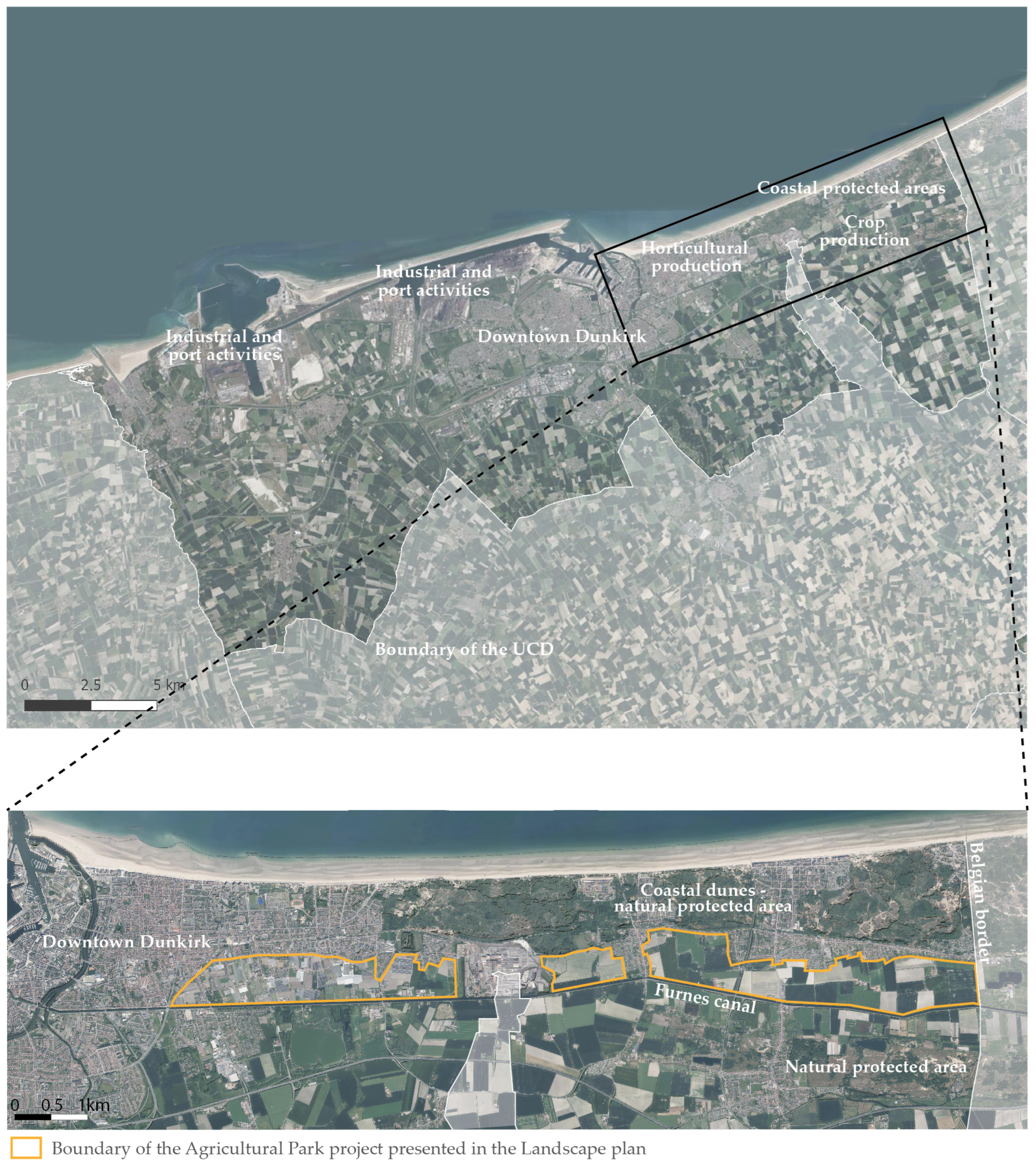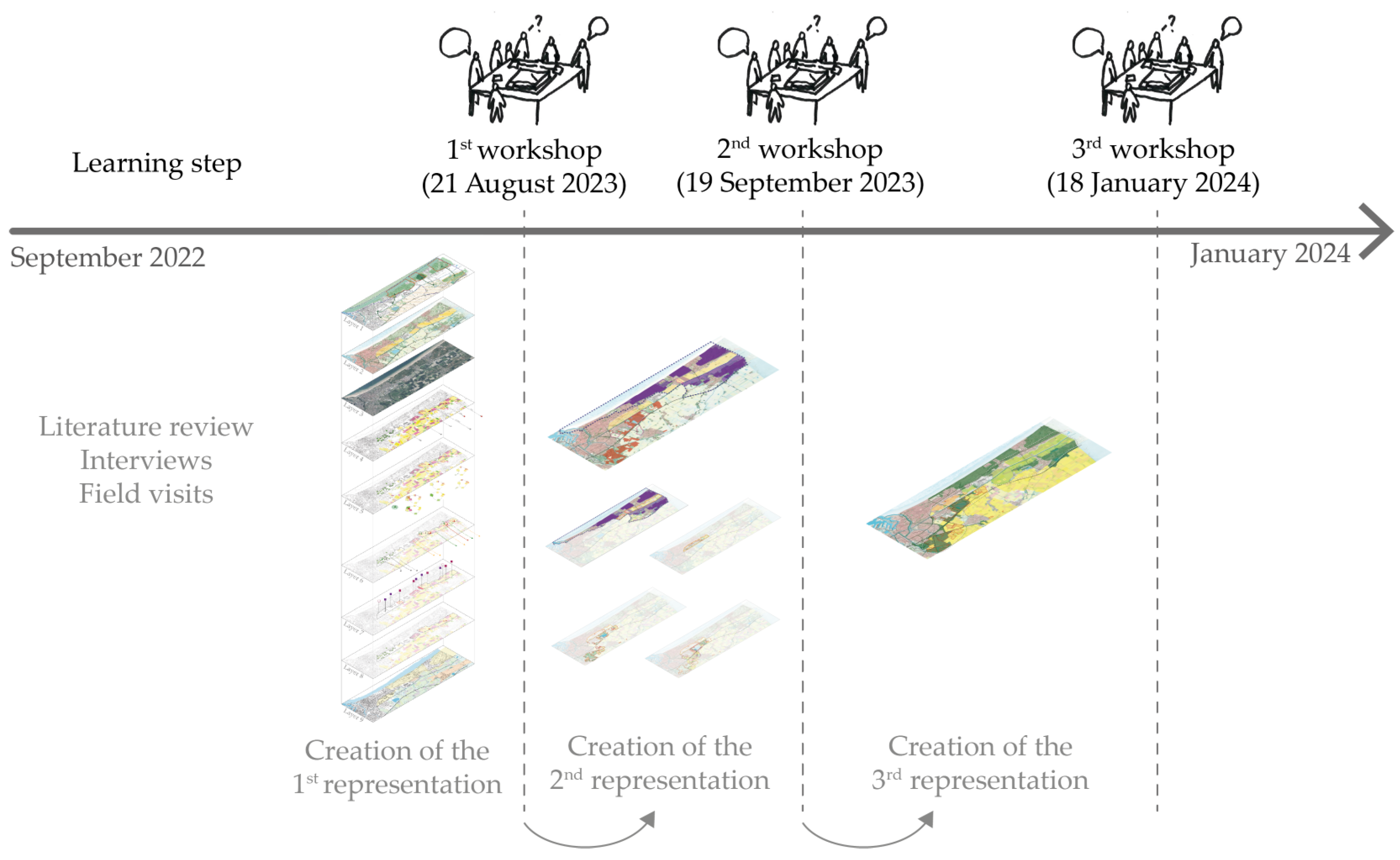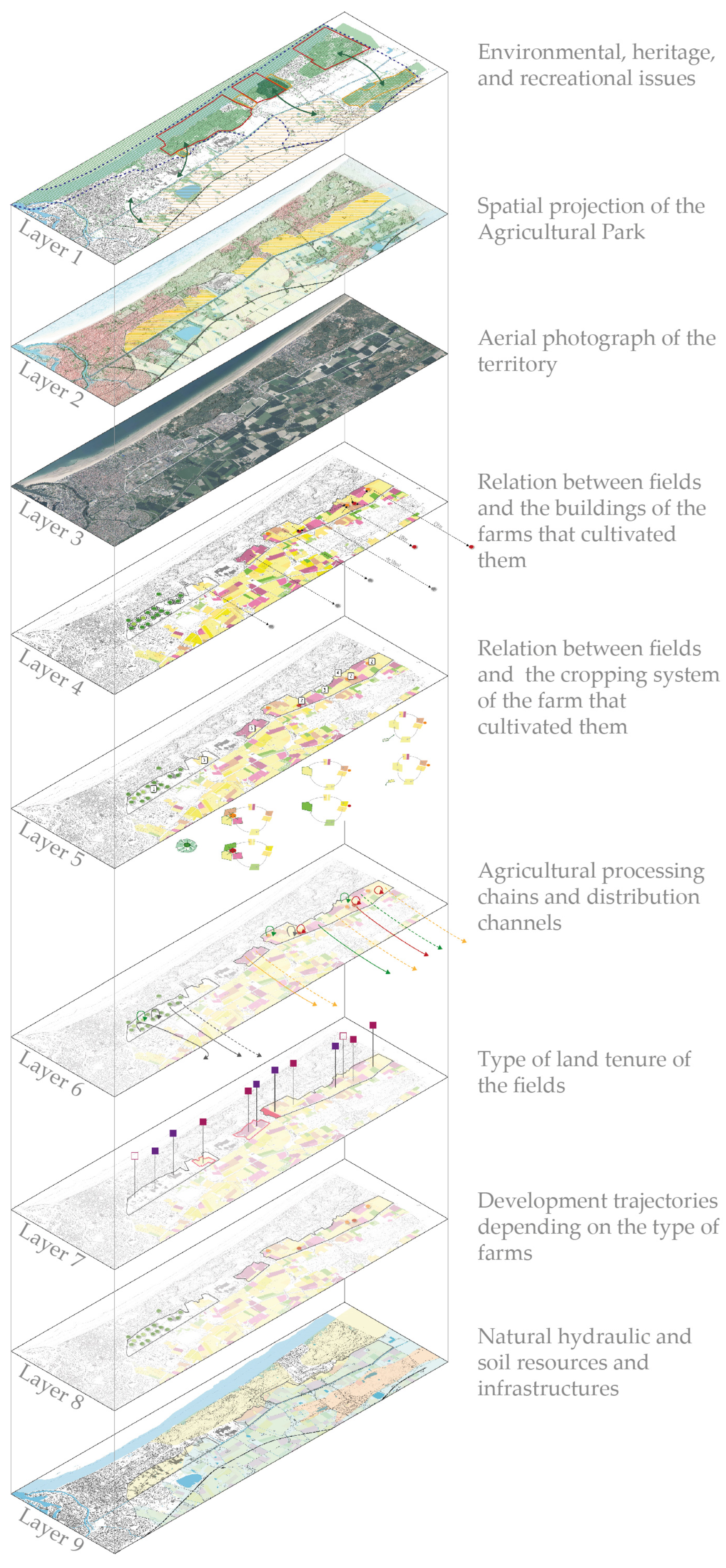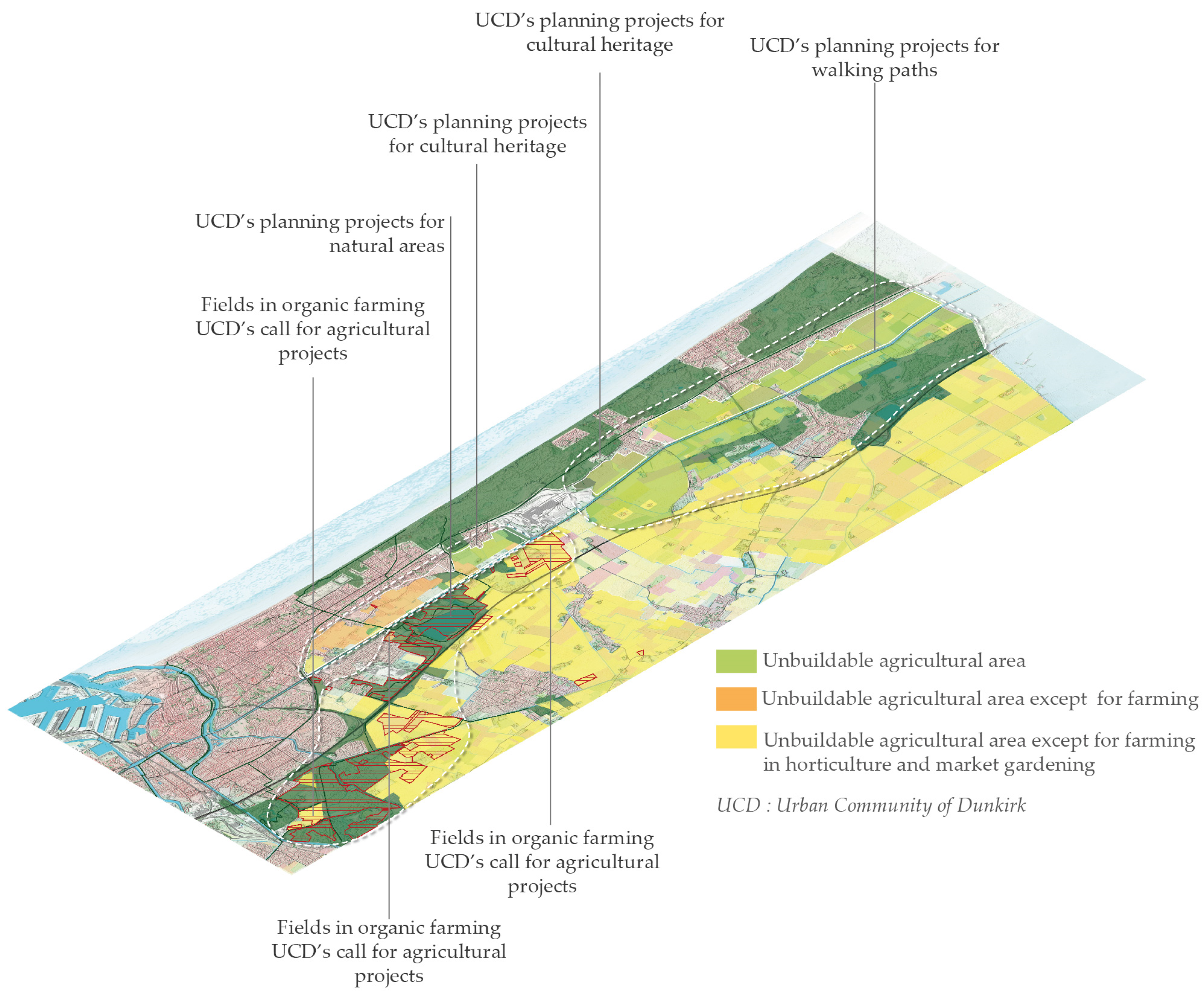A Methodological Framework to Enhance Potential Spatial Planning to Support Agroecological Transition at the Scale of Local Territories
Abstract
1. Introduction
2. A New Methodological Framework Towards Designing Spatial Configurations for Agroecology at the Territorial Scale
2.1. Landscape Agronomy: Farming Systems as a Main Driver of the Spatial Configurations of Territories for Agroecology
2.2. Landscape Architects’ Approaches for Designing New Multifunctional Spatial Configurations of Territories
- In a place-based and spatially explicit way, analyse the current spatial configuration of a territory and consider the spatial configurations required to develop multiple uses. Combine these different spatial configurations to design a multifunctional area that is pleasant for all users and addresses the urban and environmental issues.
- Involve the different stakeholders of a territory to include their knowledge of the area and desire for change in the assessment and design process. To facilitate knowledge collection and discussions, focus on the sensory dimension of the landscape using images or field visits.
- Produce a map of the new spatial configuration of the territory designed. Stagger the transformations of spatial configuration over time to guide their implementation.
2.3. A New Framework at the Interface between Landscape Architecture and Landscape Agronomy
- Include the spatial functioning of farming systems and ecological processes, as well as the spatial interactions among farming systems, ecological processes, and the spatial configurations of agricultural areas, in the place-based and spatially explicit analysis of the spatial configurations of the territory. Combine these spatial configurations specific to agriculture with those related to other territorial issues to imagine the changes in the spatial configuration of the territory.
- Involve both agricultural and non-agricultural stakeholders to include their knowledge of the territory and their desire for change in the assessment and design process. Agricultural stakeholders are farmers who make the decisions on agricultural land use and management depending on their farming systems, or their representatives. To do this, develop frameworks for meetings that are adapted to the specific professional characteristics of agricultural stakeholders (e.g., work rhythm, seasonality, constraints of livestock farming) and adapt the representations based on the sensory dimension of the landscape so that they can represent the spatial issues of agriculture. These representations should enable the stakeholders to share the knowledge about and discuss the multiple issues that face the area.
- Include the dynamics and uncertainties specific to agriculture in the process of designing the new spatial configurations and in the timescales planned for implementing the transformations. To do this, the aim of the process is not to produce a final alternative spatial configuration but to mobilize the spatial representations to enable the stakeholders to gradually imagine the transformations of the spatial configuration adapted to the changes in the issues, and in particular to the changes in the agricultural dynamics.
3. Application to the Urban Community of Dunkirk
3.1. Materials and Methods
3.1.1. The Territory of the Urban Community of Dunkirk
3.1.2. Qualitative Analysis of the Data Collected during the Experiment
3.2. Results: Implementing the Initial Steps of Multi-Stakeholder Spatial Projection
- -
- Layer 1 represented the environmental, heritage, and recreational issues highlighted in the Landscape Plan.
- -
- Layer 2 was a plan of the Agricultural Park proposed in the Landscape Plan.
- -
- Layer 3 was an aerial photograph of the territory used to provide spatial references in the existing space.
- -
- Layer 4 represented how the fields located within the Agricultural Park boundary are related to the buildings of the farms that cultivated them. These buildings could be located near the cultivated fields or several kilometres away. In the eastern end of the Agricultural Park, occupied by mixed-crop and mixed crop–livestock farms, most buildings were located outside of the Agricultural Park boundary. The changes in these cultivated areas for the Agricultural Park project thus needed to consider places located outside of the boundary.
- -
- Layer 5 represented that the fields within the Agricultural Park boundary were included in the cropping system of the farm that cultivated them and were related to the farm’s other fields. Their role in the system depended on the type of farm, field size, grouping of fields, and proximity to the buildings. The changes in these fields for the Agricultural Park thus influenced the entire system, including the fields outside of the boundary.
- -
- Layer 6 represented how the fields located within the Agricultural Park boundary are involved in the agricultural processing chains and distribution channels, most of which were national or international. The changes in the farming activities towards the short distribution channels would have an influence beyond these fields and require moving away from the existing channels and building new ones.
- -
- Layer 7 represented that not all the fields within the Agricultural Park boundary had the same type of land tenure. The land owned by farmers or subject to long-term rural leases are important for farmers because they represent long-term stability. Fields subject to insecure leases or threatened by urban development can represent a risk for farms and limit farmers’ commitment to new projects. Within the Agricultural Park, the potential to convert the fields may therefore depend on the current land tenure.
- -
- Layer 8 represented that the types of farms within the Agricultural Park boundary had different development trajectories related to the age of the farm manager, recent financial investments, number of employees, or the farmers’ groups to which a farmer belonged. The trajectories may represent the mechanisms for or obstacles to implementing the desired transformations of the Agricultural Park.
- -
- Layer 9 represented that the farming practices interact with the territory’s natural hydraulic and soil resources, and infrastructure (e.g., buildings, roads, paths). These interactions need to be considered to establish new farming activities and assess the impacts of these activities on the natural resources in the Agricultural Park.
- -
- Layer 1—The boundaries of the spatial planning approaches mentioned by the managers during the first workshop were overlapped on a map of the territory, which made it possible to identify the areas where several approaches overlapped. This layer highlighted that the spatial planning approaches applied to a variety of agricultural areas.
- -
- Layer 2—The first situation was based on the boundary of the Opération Grand Site of the Dunes de Flandre, which included that of the Conservatoire du littoral’s (i.e., coastal protection agency’s) land-acquisition policy and the eastern part of the Agricultural Park boundary. This boundary defined a situation in which the preservation of natural areas, ecological network, and landscape enhancement and the development of walking areas applied to the agricultural areas cultivated by mixed-crop and mixed crop–livestock farms. In this situation, the absence of public land in agricultural areas limited the UCD’s courses of action.
- -
- Layer 3—The second situation was based on the western part of the Agricultural Park boundary and was not influenced by the boundaries of the other spatial planning approaches. This boundary defined a situation in which the establishment of market gardening systems for local food supplies and the development of recreation and walking areas applied to the agricultural areas cultivated mainly by horticultural systems. In this situation, the absence of public land in the agricultural areas also limited the UCD’s courses of action.
- -
- Layer 4—The third situation was based on the boundary defined by the agricultural land owned by the UCD and was not influenced by the boundaries of the other spatial planning approaches. This boundary defined a situation in which the UCD could use the public nature of the land to implement mechanisms such as environmental rural leases or the establishment of farmers who met the predefined specifications. This situation applied to the agricultural areas cultivated mainly by mixed-crop farms near the urban areas or nature and recreation areas.
- -
- Layer 5—The fourth situation was based on the agricultural areas located at the interface of the boundaries of the Agricultural Park, agricultural land owned by the UCD, and urban development projects of the local urban development plan. This situation applied to the fragmented agricultural areas, mainly mixed-crop farms subjected to urban pressure.
4. Discussion
5. Conclusions
Author Contributions
Funding
Data Availability Statement
Acknowledgments
Conflicts of Interest
References
- Altieri, M.A.; Nicholls, C.I.; Montalba, R. Technological Approaches to Sustainable Agriculture at a Crossroads: An Agroecological Perspective. Sustainability 2017, 9, 13. [Google Scholar] [CrossRef]
- Cairol, D.; Coudel, E.; Knickel, K.; Caron, P.; Kröger, M. Multifunctionality of Agriculture and Rural Areas as Reflected in Policies: The Importance and Relevance of the Territorial View. J. Environ. Policy Plan. 2009, 11, 269–289. [Google Scholar] [CrossRef]
- Duru, M.; Fares, M.H.; Therond, O. A conceptual framework for thinking now (and organising tomorrow) the agroecological transition at the level of the territory. Cah. Agric. 2014, 23, 84–95. [Google Scholar] [CrossRef]
- Landis, D.A. Designing agricultural landscapes for biodiversity-based ecosystem services. Basic Appl. Ecol. 2017, 18, 1–12. [Google Scholar] [CrossRef]
- Smithwick, E.A.H.; Baka, J.; Bird, D.; Blaszscak-Boxe, C.; Cole, C.A.; Fuentes, J.D.; Gergel, S.E.; Glenna, L.L.; Grady, C.; Hunt, C.A.; et al. Regenerative landscape design: An integrative framework to enhance sustainability planning. Ecol. Soc. 2023, 28, 5. [Google Scholar] [CrossRef]
- Worosz, M.R. Transdisciplinary research for wicked problems. Agric. Hum. Values 2022, 39, 1185–1189. [Google Scholar] [CrossRef]
- Girard, N.; Magda, D. Les jeux entre singularité et généricité des savoirs agro-écologiques dans un réseau d’éleveurs. Rev. D’anthropologie Des Connaiss. 2018, 12, 199–228. [Google Scholar] [CrossRef]
- Pignal, A.C.; Lucas, V.; Boulet, A.; Blondel, L.; Gasselin, P.; Cittadini, R. CAP VERT—Comprendre, vivre et accompagner la transition agroécologique en collectif. Innov. Agron. 2019, 71, 165–180. [Google Scholar] [CrossRef]
- Valorge, F.; Lucas, V.; Pavie, J.; Casagrande, M.; Garcia-Velasco, A. LUZ’CO—Collective solutions to develop forage legumes LUZ’CO—Solutions collectives pour développer les légumineuses fourragères. Innov. Agron. 2021, 82, 191–204. [Google Scholar] [CrossRef]
- Gascuel-Odoux, C.; Magda, D. Gérer les paysages et les territoires pour la transition agroécologique. Innov. Agron. 2015, 43, 95–106. [Google Scholar]
- Direction Generale Collectivité Locales. Compétences-Aménager mon Territoire. Available online: https://www.collectivites-locales.gouv.fr/competences# (accessed on 9 August 2024).
- Torre, A.; Wallet, F.; Huang, J. Le foncier agricole, nouvel enjeu des politiques d’aménagement de l’espace. Économie Rural. 2023, 383, 7–13. [Google Scholar] [CrossRef]
- De Briant, V. Collectivités territoriales et environnement—2022. Rev. Jurid. De L’environ. 2023, 48, 661–673. [Google Scholar]
- Zasada, I. Multifunctional peri-urban agriculture—A review of societal demands and the provision of goods and services by farming. Land Use Policy 2011, 28, 639–648. [Google Scholar] [CrossRef]
- Benoît, M.; Rizzo, D.; Marraccini, E.; Moonen, A.C.; Galli, M.; Lardon, S.; Rapey, H.; Thenail, C.; Bonari, E. Landscape agronomy: A new field for addressing agricultural landscape dynamics. Landsc. Ecol. 2012, 27, 1385–1394. [Google Scholar] [CrossRef]
- Rizzo, D.; Marraccini, E.; Lardon, S.; Rapey, H.; Debolini, M.; Benoit, M.; Thenail, C. Farming systems designing landscapes: Land management units at the interface between agronomy and geography. Geogr. Tidsskr. 2013, 113, 71–86. [Google Scholar] [CrossRef]
- Thenail, C.; Joannon, A.; Capitaine, M.; Souchère, V.; Mignolet, C.; Schermann, N.; Di Pietro, F.; Pons, Y.; Gaucherel, C.; Viaud, V.; et al. The contribution of crop-rotation organization in farms to crop-mosaic patterning at local landscape scales. Agric. Ecosyst. Environ. 2009, 131, 207–219. [Google Scholar] [CrossRef]
- Thenail, C. Relationships between farm characteristics and the variation of the density of hedgerows at the level of a micro-region of bocage landscape. Study case in Brittany, France. Agric. Syst. 2002, 71, 207–230. [Google Scholar] [CrossRef]
- Baudry, J.; Thenail, C. Interaction between farming systems, riparian zones, and landscape patterns: A case study in western France. Landsc. Urban Plan. 2004, 67, 121–129. [Google Scholar] [CrossRef]
- Latruffe, L.; Piet, L. Does land fragmentation affect farm performance? A case study from Brittany, France. Agric. Syst. 2014, 129, 68–80. [Google Scholar] [CrossRef]
- Levin, G.; Nainggolan, D. The significance of spatial fragmentation of land ownership for occurrence of scrubs on semi-natural grasslands. Landsc. Ecol. 2016, 31, 2031–2044. [Google Scholar] [CrossRef]
- Asai, M.; Moraine, M.; Ryschawy, J.; de Wit, J.; Hoshide, A.K.; Martin, G. Critical factors for crop-livestock integration beyond the farm level: A cross-analysis of worldwide case studies. Land Use Pol. 2018, 73, 184–194. [Google Scholar] [CrossRef]
- Debolini, M.; Schoorl, J.M.; Temme, A.; Galli, M.; Bonari, E. Changes in Agricultural Land Use Affecting Future Soil Redistribution Patterns: A Case Study in Southern Tuscany (Italy). Land Degrad. Dev. 2015, 26, 574–586. [Google Scholar] [CrossRef]
- Barbottin, A.; Bouty, C.; Martin, P. Using the French LPIS database to highlight farm area dynamics: The case study of the Niort Plain. Land Use Pol. 2018, 73, 281–289. [Google Scholar] [CrossRef]
- Petit, S.; Muneret, L.; Carbonne, B.; Hannachi, M.; Ricci, B.; Rusch, A.; Lavigne, C. Chapter One—Landscape-scale expansion of agroecology to enhance natural pest control: A systematic review. In Advances in Ecological Research; Bohan, D.A., Vanbergen, A.J., Eds.; Academic Press: Dijon, France, 2020; Volume 63, pp. 1–48. [Google Scholar]
- Moreira, E.F.; Boscolo, D.; Viana, B.F. Spatial heterogeneity regulates plant-pollinator networks across multiple landscape scales. PLoS ONE 2015, 10, e0123628. [Google Scholar] [CrossRef]
- Ricci, B.; Petit, S.; Allanic, C.; Langot, M.; Parisey, N.; Poggi, S. How effective is large landscape-scale planning for reducing local weed infestations? A landscape-scale modelling approach. Ecol. Model. 2018, 384, 221–232. [Google Scholar] [CrossRef]
- Murgue, C.; Therond, O.; Leenhardt, D. Toward integrated water and agricultural land management: Participatory design of agricultural landscapes. Land Use Pol. 2015, 45, 52–63. [Google Scholar] [CrossRef]
- Casal, L.; Durand, P.; Akkal-Corfini, N.; Benhamou, C.; Laurent, F.; Salmon-Monviola, J.; Ferrant, S.; Probst, A.; Probst, J.-L.; Vertès, F. Reduction of stream nitrate concentrations by land management in contrasted landscapes. Nutr. Cycl. Agroecosystems 2019, 114, 1–17. [Google Scholar] [CrossRef]
- Puech, T.; Schott, C.; Mignolet, C. Characterising the diversity and spatial differentiation of crop managements at a regional scale. Eur. J. Agron. 2020, 120, 126112. [Google Scholar] [CrossRef]
- Viaud, V.; Angers, D.A.; Walter, C. Toward Landscape-Scale Modeling of Soil Organic Matter Dynamics in Agroecosystems. Soil Sci. Soc. Am. J. 2010, 74, 1847–1860. [Google Scholar] [CrossRef]
- Klein, T.; Holzkämper, A.; Calanca, P.; Seppelt, R.; Fuhrer, J. Adapting agricultural land management to climate change: A regional multi-objective optimization approach. Landsc. Ecol. 2013, 28, 2029–2047. [Google Scholar] [CrossRef]
- Jeanneret, P.; Aviron, S.; Alignier, A.; Lavigne, C.; Helfenstein, J.; Herzog, F.; Kay, S.; Petit, S. Agroecology landscapes. Landsc. Ecol. 2021, 36, 2235–2257. [Google Scholar] [CrossRef] [PubMed]
- Boesing, A.L.; Klaus, V.H.; Neyret, M.; Le Provost, G.; Peter, S.; Fischer, M.; Manning, P. Identifying the optimal landscape configuration for landscape multifunctionality. Ecosyst. Serv. 2024, 67, 101630. [Google Scholar] [CrossRef]
- Thenail, C.; Moonen, A.-C.; Lardon, S.; Marraccini, E.; Rizzo, D. Landscape Agronomy: Lessons Learned and Challenges Ahead, from a European Perspective. In Landscape Agronomy: Advances and Challenges of a Territorial Approach to Agricultural Issues; Rizzo, D., Marraccini, E., Lardon, S., Eds.; Springer International Publishing: Cham, Switzerland, 2022; pp. 271–294. [Google Scholar]
- Follea, B.; Gomel, C.; Parrouffe, J.-M.; Richard, N.; Schmid, L.; Thibault, J.-P. Réussir la Transition Écologique par L’approche Paysagère; La Fabrique Écologique: Paris, France, 2024; Available online: https://www.lafabriqueecologique.fr/reussir-la-transition-ecologique-par-lapproche-paysagere-2/ (accessed on 16 October 2024).
- MTE, M.d.l.t.é. Objectif Paysages. Available online: www.objectif-paysages.developpement-durable.gouv.fr (accessed on 22 December 2023).
- Council of Europe. European Landscape Convention 2000; Eds Council of Europe, European Treaty Series no.176. Available online: https://rm.coe.int/16807b6bc7 (accessed on 16 October 2024).
- Bonin, S.; Follea, B. Projet de paysage, projet agricole et design territorial. Agron. Environ. Société 2018, 8, 31–40. [Google Scholar]
- Voisin, L.; Cénet, A.; Génuite, I.; Viaud, V. Ouvrir le champ des possibles. Comment les pratiques paysagistes entrent en agriculture? Proj. Paysage 2024, 30. [Google Scholar] [CrossRef]
- Tress, B.; Tress, G.; Décamps, H.; d’Hauteserre, A.-M. Bridging human and natural sciences in landscape research. Landsc. Urban Plan. 2001, 57, 137–141. [Google Scholar] [CrossRef]
- Sayer, J.; Sunderland, T.; Ghazoul, J.; Pfund, J.L.; Sheil, D.; Meijaard, E.; Venter, M.; Boedhihartono, A.K.; Day, M.; Garcia, C.; et al. Ten principles for a landscape approach to reconciling agriculture, conservation, and other competing land uses. Proc. Natl. Acad. Sci. USA 2013, 110, 8349–8356. [Google Scholar] [CrossRef]
- Pereponova, A.; Grahmann, K.; Lischeid, G.; Bellingrath-Kimura, S.D.; Ewert, F.A. Sustainable transformation of agriculture requires landscape experiments. Heliyon 2023, 9, e21215. [Google Scholar] [CrossRef]
- Pinto-Correia, T.; Kristensen, L. Linking research to practice: The landscape as the basis for integrating social and ecological perspectives of the rural. Landsc. Urban Plan. 2013, 120, 248–256. [Google Scholar] [CrossRef]
- Kristensen, L.S.; Primdahl, J. Landscape strategy making as a pathway to policy integration and involvement of stakeholders: Examples from a Danish action research programme. J. Environ. Plan. Manag. 2019, 63, 1114–1131. [Google Scholar] [CrossRef]
- Primdahl, J.; Folvig, S.; Kristensen, L.S. Landscape Strategy-Making and Collaboration. The Hills of Northern Mors, Denmark; A Case of Changing Focus and Scale. Land 2020, 9, 189. [Google Scholar] [CrossRef]
- Primdahl, J.; Kristensen, L.S.; Swaffield, S. Guiding rural landscape change. Appl. Geogr. 2013, 42, 86–94. [Google Scholar] [CrossRef]
- Kristensen, L.S.; Pears, D.Q.; Primdahl, J. Guiding Multifunctional Landscape Changes Through Collaboration: Experiences from a Danish Case Study. In Landscape Agronomy: Advances and Challenges of a Territorial Approach to Agricultural Issues; Rizzo, D., Marraccini, E., Lardon, S., Eds.; Springer International Publishing: Cham, Switzerland, 2022; pp. 247–270. [Google Scholar]
- Pernet, A. Le Grand Paysage en Projet. Histoire, Critique et Expérience; Metis Presses: Geneva, Switzerland, 2014. [Google Scholar]
- Chambre Agriculture. L’agriculture sur le Territoire de la Communauté Urbaine de Dunkerque; Chambre d’agriculture du Nord-Pas de Calais: Saint-Laurent-Blangy, France, 2017. [Google Scholar]
- Baumgarten, S.; Aarts, N.; Fliervoet, J.M.; Krabbenborg, L. Dynamics and Dependencies in Regional Collaboration for Biodiversity Restoration: Reflections from The Netherlands. Environ. Manag. 2024. [Google Scholar] [CrossRef] [PubMed]





Disclaimer/Publisher’s Note: The statements, opinions and data contained in all publications are solely those of the individual author(s) and contributor(s) and not of MDPI and/or the editor(s). MDPI and/or the editor(s) disclaim responsibility for any injury to people or property resulting from any ideas, methods, instructions or products referred to in the content. |
© 2024 by the authors. Licensee MDPI, Basel, Switzerland. This article is an open access article distributed under the terms and conditions of the Creative Commons Attribution (CC BY) license (https://creativecommons.org/licenses/by/4.0/).
Share and Cite
Cénet, A.; Viaud, V.; Voisin, L. A Methodological Framework to Enhance Potential Spatial Planning to Support Agroecological Transition at the Scale of Local Territories. Land 2024, 13, 1707. https://doi.org/10.3390/land13101707
Cénet A, Viaud V, Voisin L. A Methodological Framework to Enhance Potential Spatial Planning to Support Agroecological Transition at the Scale of Local Territories. Land. 2024; 13(10):1707. https://doi.org/10.3390/land13101707
Chicago/Turabian StyleCénet, Amélie, Valérie Viaud, and Lolita Voisin. 2024. "A Methodological Framework to Enhance Potential Spatial Planning to Support Agroecological Transition at the Scale of Local Territories" Land 13, no. 10: 1707. https://doi.org/10.3390/land13101707
APA StyleCénet, A., Viaud, V., & Voisin, L. (2024). A Methodological Framework to Enhance Potential Spatial Planning to Support Agroecological Transition at the Scale of Local Territories. Land, 13(10), 1707. https://doi.org/10.3390/land13101707






